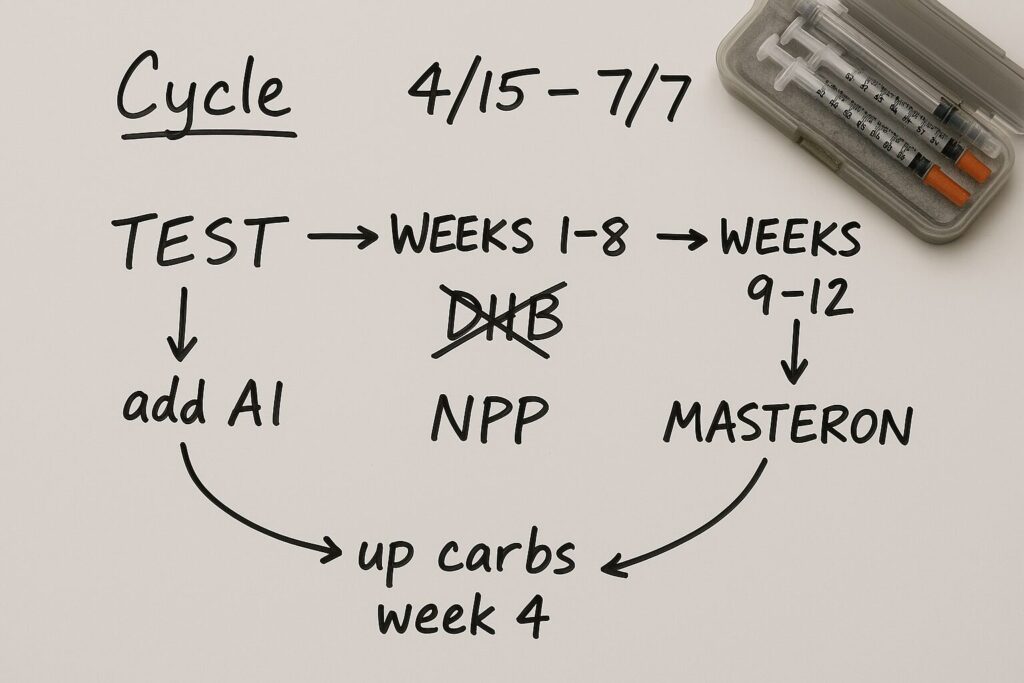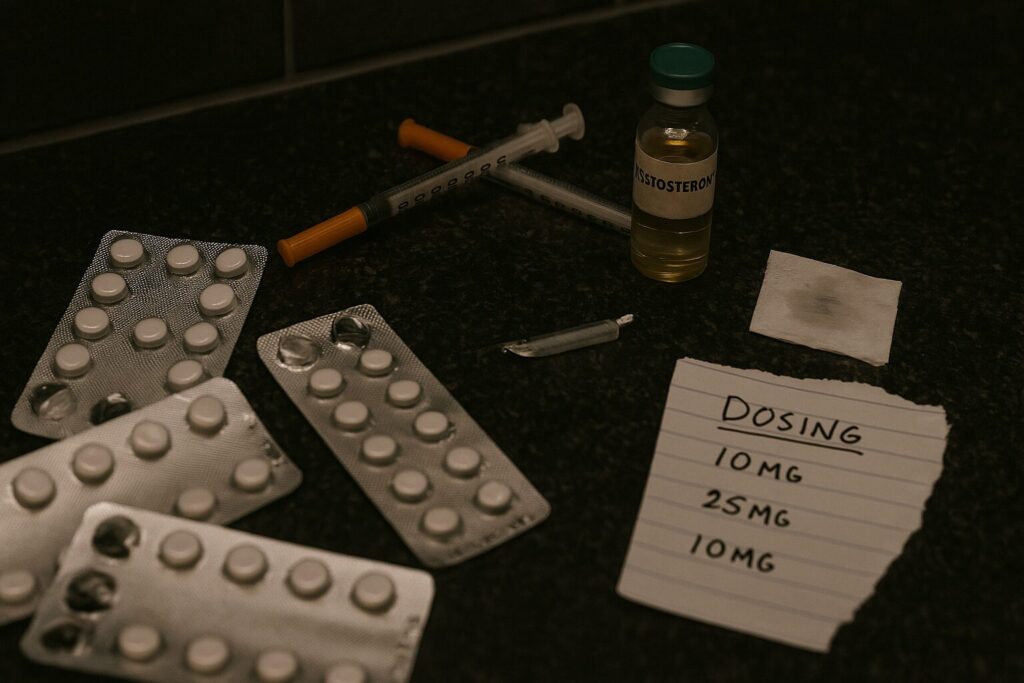The Fundamentals: What Are Anabolic Steroids, Really?
Beyond Buzzwords and Bro-Science
So—what are anabolic steroids?
You’ve heard a dozen definitions. Some correct, some laughably off.
Technically?
They’re synthetic derivatives of testosterone designed to boost protein synthesis, support nitrogen retention, and enhance muscle recovery. Basically—they turn your body into a more efficient, more anabolic version of itself.
Sounds clean. Clinical.
But in the gym? In the locker room? That’s not how we talk about it.
We say stuff like:
– “Helps me train harder, bounce back faster.”
– “Man, I’m not even sore the next day.”
– “I can hit legs three times a week and still walk.”
Here’s the deal though, let’s cut the fluff:
They’re tools. Chemical tools.
Like creatine—but amplified. Like food—but compressed into molecules with attitude.
You’re not injecting muscle.
You’re manipulating your internal recovery engine so it runs hotter, cleaner, longer.
And yeah—it works.
That’s why you’re here, isn’t it?
But let’s go deeper.
You think testosterone enanthate and trenbolone act the same?
Guess again.
They hit different receptors, carry different conversion risks (hello estrogen), and demand very different support protocols.
Confused? You shouldn’t be.
This isn’t theory for you—it’s weekly protocol.
Why Lifters Actually Use Them
It’s Not Just About Bigger Quads
You already know the textbook reasons.
Muscle. Recovery. Strength.
But if that’s all it was, nobody would risk the side effects—or lie about using.
So why?
– Because 2.5 kg PRs aren’t exciting anymore
– Because grinding for years with no visible changes wrecks your head
– Because the natty ceiling hits harder than leg day after a deload
Let’s be honest.
Most guys don’t start because of science. They start because they’re stuck.
You’ve been there. Staring in the mirror.
Lifting heavy. Eating clean. Sleeping right. Still… flat.
Someone in your gym throws on 20 pounds of lean mass in 8 months, and he’s smiling. You’re not. That’s how it starts.
Does it help?
Yeah—it does.
But the psychological switch might be the bigger piece.
Once you realize you’re not limited to natural output, everything shifts.
Workouts feel different.
Recovery feels infinite.
And suddenly, intensity doesn’t scare you anymore—it invites you.

The Real Effects Lifters Talk About
Not in Studies—In Gyms, DMs, and Group Chats
Forget what the brochures say.
What do guys actually feel?
Strength? Sure. That’s expected.
But it’s the other stuff—the subtle shifts—that get talked about behind the scenes.
You might hear:
- “I recover like a machine, even after max effort days.”
- “Appetite’s up. Way up. I’m eating like a bear in bulk mode.”
- “I stopped counting reps. I just go until it feels stupid to stop.”
And then there’s focus.
That tunnel vision during a heavy set?
It changes. Gets deeper. Not like caffeine deep—more like controlled aggression. Calm chaos.
But not all gear hits the same.
Dianabol gives you that early bloaty strength—big pumps, fast weight jumps.
Testosterone enanthate? Smoother. Less flashy. Feels like a background force cranking the system up.
Anadrol? If you know, you know. Strength, yes. But also blood pressure through the roof. Use it wrong and your head feels like it’s going to pop mid-deadlift.
And that’s just the orals.
Injectables? Whole different rhythm.
Some swear by Sustanon 250 for its time-release curve. Others go steady with test-e, mixing in a little trenbolone when they want that hardened, no-fat look.
But again—you knew that.
The point is this: the effects go beyond what you’ll read in sterile clinical descriptions.
Gear changes your output, sure.
But it also changes your relationship with training.
Cycles: The Structure Inside the Chaos
(Or the Chaos Inside the Structure?)
Let’s clear one thing up—no one actually runs a textbook cycle.
Not really. Not once they’ve done it twice.
Sure, it starts with a plan:
– 500mg test-e per week
– 30mg dbol pre-workout
– 12 weeks on, 4 off, maybe a mild PCT
– Clean meals. Water. Bloods.
That’s how it looks in forums. On spreadsheets.
Reality? Way messier.
You forget a pin.
Your source goes dark.
You’re sick, or injured, or broke.
Your libido spikes then flatlines. You swap dbol for anadrol halfway because… why not? It’s working better for your training split.
Suddenly that “structured cycle”?
It’s Frankenstein.
But here’s the thing—most lifters learn through that.
Through screw-ups.
Through miscalculated half-lives and delayed side effects that creep in after week 8 and then boom—crash.
Cycles aren’t clean arcs.
They’re survival curves.
Feedback loops.
You adjust. You pivot. You keep lifting.
And if you don’t track your doses, bloodwork, changes in sleep, hunger, drive—
You’re not cycling.
You’re gambling.

Training While On
Everything Feels Heavier. And Lighter. And… Different.
There’s a moment about two weeks in—maybe three—when you walk into the gym and something feels off. But not bad. Just… different. The bar feels alive. It moves before you even pull. Warm-ups blur into working sets without warning, and suddenly, your normal RPE scale doesn’t work anymore. What felt like an 8 last week is a 5 now, but you still sweat, your heart still races—only you recover in time to do it again in five minutes. Maybe less. Maybe right now. You keep going.
You stop counting reps because the pump tells you more than numbers can. Your shoulders swell mid-set. Your forearms ache from the sheer volume of blood. You get greedy for more. “One more plate” becomes the default—because why not? The bar speed’s still there. Your knees feel stable. Your low back isn’t barking. Your joints? A little stiff maybe, but manageable, and you’ll stretch later. Probably. Or not. Who cares—it’s squat day.
There’s also the aggression. Not rage, not like Hollywood says, but something quieter. Focused. Sharper. You’re less chatty. More mechanical. Maybe you nod at someone. Maybe you don’t. You used to train and talk between sets. Now? Just music. Chalk. Plates. And that mirror—catching the corner of your eye when you hit depth and thinking, “That’s not me. That can’t be me. That’s someone bigger.” You smirk. You hit another rep.
But you’re not invincible. You still fatigue. Just later. Deeper. And it’s not muscle that gives out first—it’s something else. Tendons. Sleep. A weird ache behind your knee. Or the sense that you should stop but you won’t. Not yet. You’re riding it. And you know the crash will come—later—but that’s not today’s problem.
You train harder because you can. You don’t know what you’re chasing exactly, but you’ll know it when you hit it. Or when your elbow starts screaming. Or when someone you haven’t seen in weeks says: “Bro… what are you on?”
And you don’t answer.
Because they already know.
The Mental Shift
You expect strength. But not this shift inside your head.
There’s a new kind of drive—not loud, not dramatic. Just constant. You want to lift. Every day. And then again at night. Sometimes it’s actual hunger. Sometimes it’s just energy leaking out of you, needing to go somewhere.
You think clearer, but with tunnel vision.
You sleep worse but somehow feel stronger.
You care less about soreness, even if it’s still there.
You check mirrors more often, not even for ego—just tracking.
You plan lifts in your head during conversations.
At dinner. During work. While driving. It creeps in.
And progress? It hits different. Not just weight on the bar.
Clothes fit wrong. Forearms bulge. Neck thickens. People stare.
You get compliments you’re not sure how to respond to.
You get used to it.
That’s the scary part.
Side Effects Nobody Brags About
Most guys won’t talk about these. Not online. Not even to their coach. You just start seeing signs.
Your skin changes first. A little more oily. A few spots on your shoulders. Not dramatic, but it’s there. You wipe the bench more often now.
Then there’s sleep. You fall asleep fast, sure. But you wake up drenched. Some nights your pulse won’t slow down until 3 a.m. You learn to live with it. Some guys use melatonin. Others don’t bother. Training makes up for it.
Blood pressure? You probably don’t check. You should, though.
A 2018 study in JAMA Cardiology showed long-term anabolic steroid use can significantly increase left ventricular dysfunction, even in users who appear otherwise healthy.
You’ll also notice your resting heart rate ticking higher.
Small thing. Until it’s not.
That pump? It’s coming with pressure now.
Test levels spike, yeah—but estrogen rises too. That’s biology. Your body tries to balance.
A peer-reviewed study published in Drug Testing and Analysis explains how testosterone-based cycles (like testosterone enanthate or Sustanon 250) can cause estradiol levels to surge—leading to water retention, mood swings, and occasional breast tissue formation (yeah, that) source.
No one tells you about the weird emotional shifts.
Not always anger. Sometimes it’s just… flat. Like nothing feels exciting. Until it does—and it hits like a freight train.
But here’s the thing.
None of this will stop you from training.
You’ll adjust. You’ll experiment. You’ll keep going.
Because you can manage the sides.
And the progress? Still worth it—for now.
Orals vs Injectables
You think it’s just about timing. About which one kicks in quicker, or which one makes you look different by week three. It’s not. It’s about control—or the illusion of it. Because everyone starts with structure: daily tabs, clean pins, calendar cycles. Until life smashes that to hell. You miss a dose. You lose your source. You forget if you took your liver support that morning, or was that yesterday?
Dianabol bloats one guy like a water balloon. The next? Just endless pumps. Trenbolone makes someone stronger, leaner, clearer. Makes someone else sweat through their sheets, snap at their girlfriend, and quit after week six. Injectables feel “safe” because they come with a needle and a schedule. But you forget how long they linger. Miss one shot, and your hormone profile doesn’t crash—it drifts. Uncomfortably. Sometimes for weeks.
💊 Messy Table: What Lifters Say (Not What the Brochure Says)
| Orals | Injectables | |
|---|---|---|
| Kick-in | Fast—sometimes too fast | Slower, but steadier (depends on ester) |
| Examples | Dianabol, Anadrol, Turinabol | Testosterone Enanthate, Sustanon 250, Trenbolone |
| Liver Load | Heavy. Most people forget this after week four | Lighter, but still needs support |
| Pinning | None. Easy. You just swallow and go. | Needles, schedule, some prep, some stress |
| Side Notes | Can crush appetite, spike mood, or just feel dirty | Some feel nothing… until they stop |
| Stacking | Easy to overdo (cheap, fast, too accessible) | Safer for long cycles—but harder to walk away from |
You look at a table like that and think: simple. It’s not.
It’s a starting point, sure.
But half of it’s lies you’ll believe until your body disagrees.
The rest? Trial and error—and you’re the experiment.

The Come-Down Isn’t a Collapse
(But You Do Feel It)
It’s not a cliff. More like a slow fade.
One week you’re pushing numbers that made you grin mid-set. Then, things feel… a little heavier. Not terrible. Just heavier in the wrong way. Not muscle failure—more like the gears grinding instead of gliding.
You finish your cycle. You start PCT. Maybe clomid, maybe nolvadex, maybe something cleaner. You already planned this part. Or at least, told yourself you did.
And yeah—it works. Eventually. Your energy picks up, mood stabilizes, sleep returns. Hormones swing for a while but you’ve seen worse from a bad flu.
Strength? That’s the thing. You keep most of it if you played smart. Not all. Not those freakish numbers you hit on week eight when sleep was optional and pumps lasted two days. But enough to not feel like you’re starting over.
The mental edge fades too. You miss the intensity. But it’s manageable.
You train through it. You don’t stop.
Because this wasn’t your peak. It was just a phase.
And you know what to do now.
How People Make It Work
(And Why That Looks Different for Everyone)
Some run cycles twice a year. Others cruise. A few never stop—until something forces them to.
Most lifters? They find a rhythm that fits their life, not the internet. Maybe it’s a cycle every winter. Maybe it’s TRT after a few heavy years took a toll. Maybe it’s just knowing the line—and flirting with it less each time.
You get smarter with experience. You drop compounds that make you feel off. You stop chasing weight at the cost of digestion, sleep, blood pressure, or relationships. You learn what actually works for your body—not some shredded guy’s protocol in a YouTube comment section.
And the truth is, most of this becomes routine. Not glamorous. Not chaotic. Just another part of how you lift, eat, recover, think. The emotion fades. The reaction fades. You stop talking about it. You just do it or don’t. No big thing.
The weights come and go. Strength peaks, then pulls back. But you’re still there, under the bar. Moving forward. Adjusting.
Not perfect. Not broken. Just built different than before.
This Is the Game
(And You’re Not Playing by Accident)
In high-level strength sports?
This isn’t taboo.
It’s expected. Quietly. Loudly. Depends on the room.
You think world-record squatters stay “clean” through five meets a year? They don’t.
You think Olympic hopefuls don’t use loopholes, timing, chemistry? They do.
It’s not cheating. It’s preparation—just at a different level of precision.
If you want to win, if you want to go all in, if you want to see what your body can really become when the brakes come off—this is part of that world.
No shame in that.
Just don’t forget the rest of it.
The real flex? Knowing when to pull back. Knowing how to recover.
PCT isn’t just some bonus add-on. It’s the reset button. It’s how you make sure you keep living the life—lifting, eating, thinking clearly—after the cycle’s done.
Do it right, and you keep moving forward.
Not wrecked. Not lost. Just rebuilt. Stronger, smarter.
You want to be more than average?
You already are.
